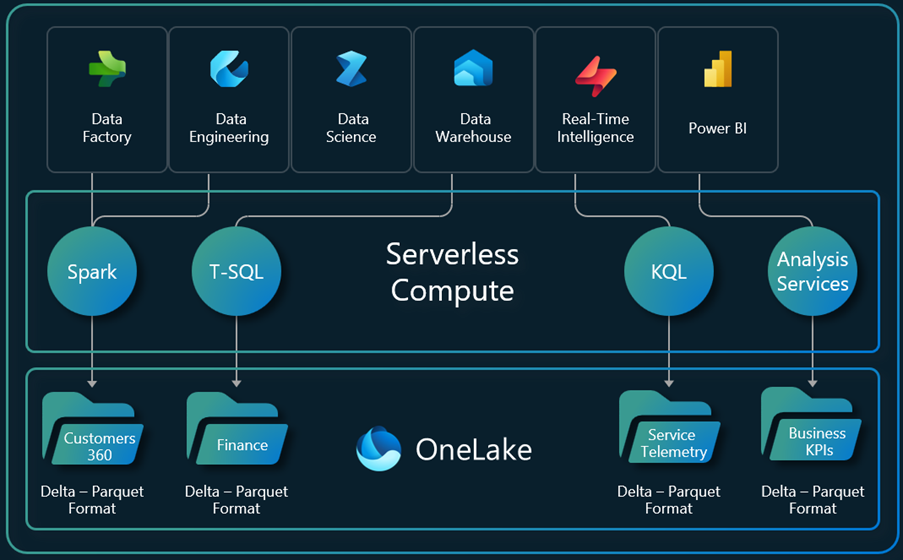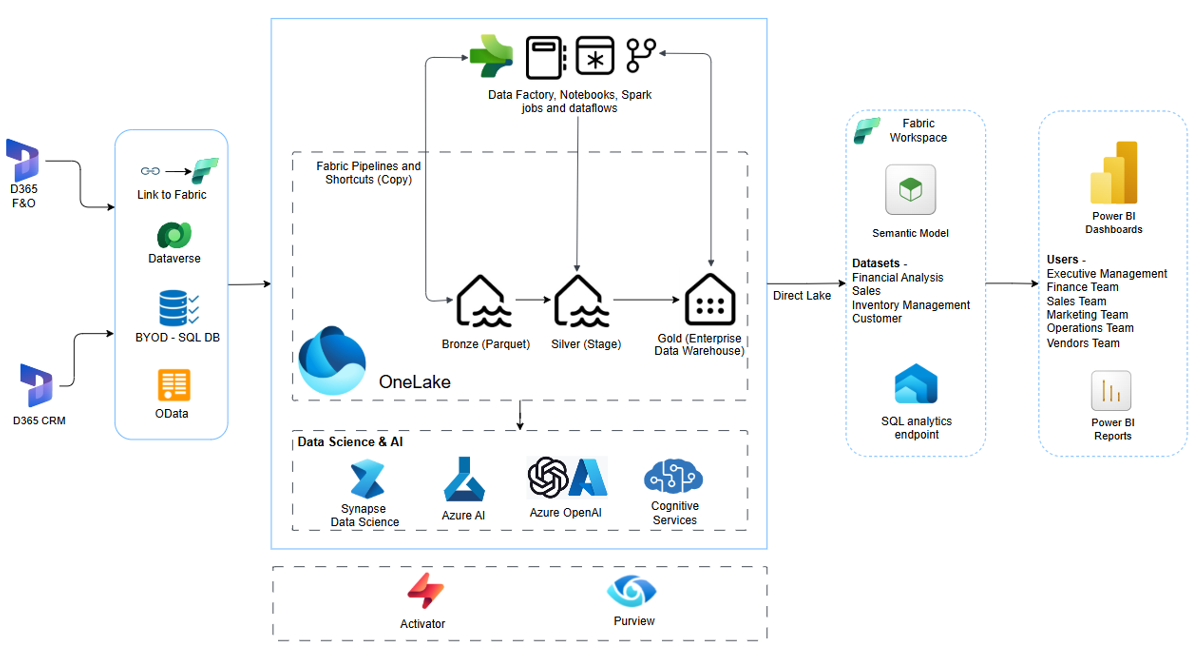August 21, 2025 - by Hiren Kapadia
Gut instinct is no longer a competitive strategy. While executives chase agility and precision, many overlook a powerful asset hiding in plain sight: the operational data inside their Microsoft Dynamics 365 ERP system. Every invoice, transaction, and customer interaction contains signals that could drive smarter decisions; yet most organizations treat this data as exhaust, not fuel.
Imagine if your data wasn’t just a record of the past, but a real-time driver of what happens next.
Microsoft Fabric simplifies how organizations manage and work with data. It combines data integration, transformation, and governance tools in one place. When used alongside Microsoft Dynamics 365 ERP, it can help organizations use their operational data better by enabling more timely analysis and insights, including using AI where appropriate.
Let’s explore how this transformation plays out in the real world through practical examples of how organizations use these tools to outpace their competition.
Turning Dynamics 365 Data into Insights with Microsoft Fabric
Every transaction, customer interaction, invoice, and process inside Microsoft Dynamics 365 ERP generates valuable data. But having data doesn’t automatically mean you’re gaining insight from it. Too often, this data is left sitting in silos, disconnected from decisions.
Unlocking value means rethinking how you treat Dynamics 365: not just as a system of record, but as a strategic asset for decision-making.
Microsoft Fabric delivers a fully integrated data platform that combines every piece of the Microsoft analytics ecosystem into a single SaaS experience.

Source: Microsoft
With its built-in data lake, Microsoft Fabric breaks down silos and seamlessly integrates data from every Microsoft Dynamics 365 process. Here’s what makes Microsoft Fabric unique:
End-to-End Data Engineering Workflow
Traditional data pipelines often involve multiple teams and tools, leading to delays, duplication, and errors. Microsoft Fabric simplifies this by enabling a complete end-to-end data engineering workflow, from ingestion to visualization.
- Data ingestion from Dynamics 365, APIs, databases, and external services, ensuring comprehensive and timely data collection
- Transformation tools like Dataflows Gen2 and Spark notebooks, enabling flexible, scalable data preparation and enrichment
- Centralized storage via OneLake, providing unified data access, seamless collaboration, and effortless reuse across teams
- Semantic modeling and metadata management within Power BI, creating a consistent, business-friendly layer for accurate data-driven insights
- Interactive visualizations and advanced analytics all within one platform, empowering users to explore and act on data effortlessly

Built-in AI that Accelerates Data-driven Insights
With Microsoft Fabric, AI is embedded directly into the experience, helping users uncover data-driven insights faster and with less manual effort. It’s not just about reporting anymore; it’s about thinking with your data.
- Copilot in Power BI offers natural language summaries, visualizations, and explanations for more accurate decision-making.
- Smart transformation suggestions based on data profiling help automate and optimize data preparation steps
- ML model integration enables predictive analytics directly within your workflows, driving proactive decision-making
- Generative AI accelerates data preparation, documentation, and dashboard creation, reducing manual effort and speeding time to insight
Governance and Security by Design
As Microsoft Dynamics 365 ERP data becomes more accessible to users, Microsoft Fabric addresses key governance, privacy, and compliance concerns. With Microsoft’s cloud security stack and Purview integration, teams get visibility and control at scale.
Fabric’s governance features include:
- Data lineage and cataloging through Microsoft Purview
- Fine-grained access control, supporting zero-trust architectures
- Compliance with global standards, such as GDPR, HIPAA, and ISO
- Audit trails and activity monitoring, ensuring accountability across roles
Real-World Use Cases
Case study 1
Business Need
A leading industrial contractor operating across the U.S. in chemical, power, and automotive sectors faced significant challenges with its legacy on-premises data systems. With complex construction and maintenance projects running across regions, data volume and complexity grew rapidly. However, fragmented systems, manual reporting, and high infrastructure costs made generating timely, actionable data-driven insights difficult. Executives lacked visibility into key metrics such as labor productivity, cost overruns, and project performance, limiting their ability to make data-driven decisions at scale.
Solution
The contractor implemented a cloud-native, scalable platform built on Microsoft Fabric to modernize its data ecosystem. This end-to-end solution unified data from systems like Dynamics 365 F&O, Viewpoint, and Procore into a single, governed Lakehouse architecture. Microsoft Fabric’s Data Pipelines, Delta Lake tables, and semantic modeling capabilities enabled complex datasets’ ingestion, refinement, and presentation for real-time reporting. Through Power BI dashboards and a layered medallion architecture, the solution delivered clean, trusted data across finance, HR, operations, and safety, empowering both corporate and field teams with on-demand data-driven insights.
Benefits
The Microsoft Fabric–powered transformation delivered immediate and long-term value.
- Reporting speed improved by 70%, reducing project status cycles from days to minutes.
- Business users gained access to secure, self-service analytics, while IT overhead dropped due to automation and centralized governance.
- The contractor eliminated legacy system costs, strengthened compliance, and created a future-ready foundation for AI-driven forecasting and analytics.
- With a unified, scalable platform, the organization can make faster, smarter decisions across every job site.
Case Study 2
Business Need
A leading building materials manufacturer, known for its innovative insulation and roofing products, was constrained by a legacy on-premises data mart. The system was costly to maintain, couldn’t scale with growing data volumes, and relied heavily on manual processes for reporting and analytics. With data coming from diverse sources like Microsoft Dynamics 365 ERP, SAP HANA, and custom systems, the company needed a modern, cloud-native platform to improve operational efficiency, reduce IT overhead, and enable real-time decision-making.
Solution
The manufacturer implemented a scalable solution using Microsoft Fabric to modernize its data platform. The project followed a phased approach, covering discovery, planning, and execution to ensure a smooth transition without disrupting operations. Key components included a metadata-driven data pipeline architecture, centralized lakehouse storage, modular ETL design, real-time data processing, and CI/CD integration through Azure DevOps. Fabric’s flexibility enabled seamless integration with existing systems while supporting near real-time analytics across business domains.
Benefits
The new platform significantly improved data operations. The company reduced infrastructure and third-party tool costs by migrating to Microsoft Fabric’s pay-as-you-go model and direct integrations. Data pipelines became faster and more reliable with built-in auditing and error handling. Reporting cycles accelerated, enabling access to real-time data-driven insights from sources like Microsoft Dynamics 365 ERP and SAP HANA. With a unified, cloud-based data foundation, the manufacturer now supports faster, more accurate analytics while ensuring long-term scalability and readiness for AI-driven use cases.
Challenges in Implementation
While Microsoft Fabric’s promise is compelling, implementing it is not without challenges.
- Breaking down data silos and aligning stakeholders on shared goals
- Upskilling teams to work with new tools like Spark or Fabric Notebooks
- Revisiting data governance frameworks to support increased access and AI usage
- Managing change resistance, especially in decentralized organizations
Overcoming these challenges requires more than just technology; it demands strategy, alignment, and the right expertise. Working with a trusted Microsoft partner can make all the difference. A knowledgeable partner brings real-world experience, accelerates onboarding, and helps you design scalable, secure, and value-driven Fabric implementations.
From building the first data pipelines to establishing governance best practices and training your teams, the right partner turns a complex transformation into a manageable and measurable journey.
Preparing your Data for Future AI Use Cases
AI is only as good as the data it learns from. For Dynamics 365 customers, preparing now ensures that your organization can take full advantage of AI innovations as they mature. Microsoft Fabric makes this preparation natural by standardizing data models through semantic layers in Power BI, making business data consistent and AI-ready.
By unifying tools, people, and data under one platform, Fabric delivers data-driven insights, stronger collaboration between business and IT, and the flexibility to scale with evolving needs. Organizations that embrace this shift will improve operational efficiency, experience higher ROI, and unlock new opportunities for innovation and growth.
About the Author
Hiren Kapadia is Director – Business Intelligence at Synoptek, with two decades of extensive experience in the Software Development Life Cycle (SDLC). Throughout this journey, Hiren has been deeply involved in numerous Data Warehousing and ETL projects, utilizing a spectrum of technologies including various database platforms, MSBI, Data Factory, Pentaho, QlikView, Power BI, Tableau, and Azure cloud-based solutions. His core responsibilities encompass many pivotal tasks such as database modeling and design, metadata management, database coding, establishing data warehouses, and crafting insightful visualizations.


